What is stimulus control in ABA

Introduction to Stimulus Control in ABA
Stimulus control is a fundamental concept in behavior analysis that describes how behaviors are influenced and regulated by environmental stimuli. Grasping this concept is vital for designing effective interventions, especially in applied behavior analysis (ABA) therapy, where establishing appropriate stimulus-response relationships can significantly impact learning and behavior modification outcomes.
Defining Stimulus Control in ABA
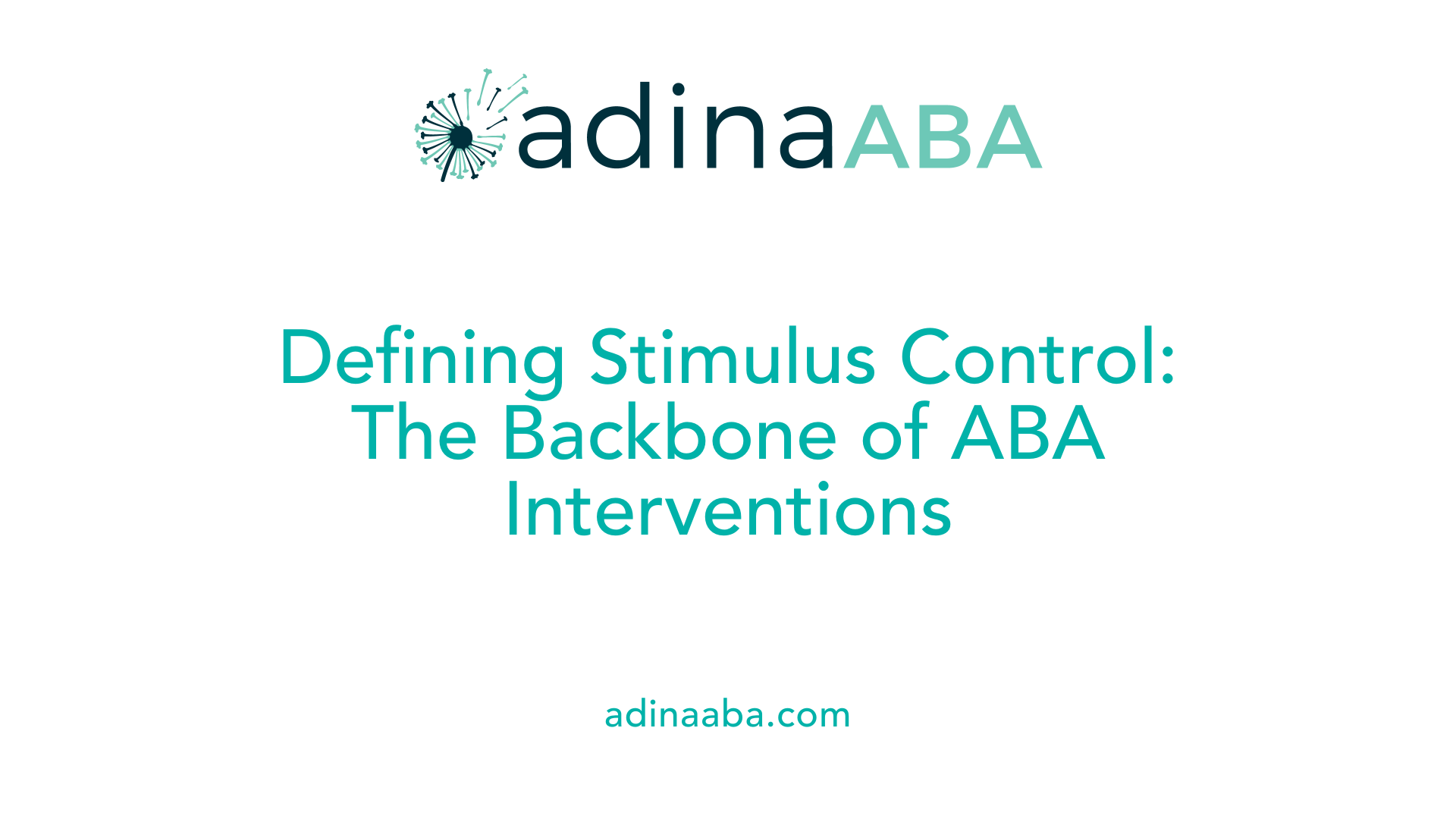
What is stimulus control in ABA therapy?
Stimulus control in ABA therapy refers to the phenomenon where a specific antecedent stimulus consistently influences an individual's behavior. When this type of control is established, behaviors are more likely to occur in the presence of certain cues and less likely when those cues are absent.
This concept involves behaviors that change in rate, latency, duration, or intensity depending on environmental stimuli. For example, a child might say 'dog' when they see a picture of a dog but not when shown a cat, demonstrating stimulus control.
The process relies heavily on principles like stimulus discrimination, where responses are reinforced only in the presence of specific stimuli, and stimulus generalization, where behaviors transfer to similar cues. Speech, social interactions, and daily routines can all be shaped through establishing stimulus control.
A common strategy in ABA is stimulus control transfer, which gradually replaces artificial prompts—like physical gestures—with natural environmental cues. This process promotes independence and helps individuals apply learned skills across different settings.
Overall, understanding and applying stimulus control is essential for teaching functional behaviors that are adaptable and natural, particularly for individuals with autism or other developmental challenges. It forms the backbone of effective ABA interventions aimed at fostering independent, spontaneous responses in everyday life.
Key Concepts Related to Stimulus Control
What are the key concepts related to stimulus control, such as discriminative stimuli and stimulus delta?
Stimulus control is centered around how specific stimuli influence whether a behavior occurs. Two primary concepts are discriminative stimuli (SD) and stimulus delta (SΔ).
Discriminative stimuli (SD) are cues that signal the availability of reinforcement for a particular behavior. When an SD is present, it increases the likelihood that the behavior will be performed because it indicates reinforcement is forthcoming. For example, a green traffic light signals drivers to go, and children might say 'bye' when prompted, knowing reinforcement (approval or attention) will follow. Reinforcement only occurs when the SD is present, strengthening the response in that context.
In contrast, stimulus delta (SΔ) signals that reinforcement will not follow the behavior. Its presence decreases the likelihood of the behavior occurring. An example would be a red light at a traffic signal; drivers know they should stop because pressing the accelerator or speeding up will not be reinforced; the behavior is suppressed.
These two concepts form the foundation of stimulus discrimination, training individuals to respond differently depending on the environmental cues. Through discrimination training, responses are reinforced in the presence of SDs and not reinforced when SΔs are present. This process strengthens the response exclusively in relevant situations.
Stimulus control also involves generalization, where behaviors learned in one context may transfer to similar stimuli. However, sometimes behaviors generalize too broadly or inappropriately, leading to faulty stimulus control.
Understanding these concepts allows practitioners to design effective interventions by controlling environmental cues, teaching appropriate responses, and minimizing behaviors triggered by irrelevant stimuli. Ultimately, mastering stimulus discrimination and effective use of SDs and SΔs enhances behavior management in settings like therapy, education, and daily life.
More on Discriminative Stimuli and Stimulus Delta in ABA
Discriminative stimuli signal when specific responses will be reinforced, guiding behavior appropriately. Stimulus delta indicates where reinforcement is unavailable, reducing unwanted responses. The ability to distinguish between these stimuli is essential for developing functional and adaptive behaviors.
Stimulus control mechanisms are employed extensively in applied behavior analysis (ABA) to foster independence, social skills, and proper responding by teaching individuals to recognize and respond correctly to environmental cues. By manipulating stimulus properties such as hue, brightness, and size, and gradually fading prompts, practitioners enhance discrimination learning.
In sum, understanding the roles of SDs and SΔs underpins effective stimulus control interventions, shaping behavior in meaningful, contextually appropriate ways.
Mechanisms of Stimulus Control and Discrimination Training

How is discrimination training used to establish stimulus control?
Discrimination training is a foundational procedure in behavior analysis used to teach individuals to respond differently to stimuli based on specific conditions. During this process, the individual receives reinforcement for behaviors performed in the presence of a certain stimulus, called the discriminative stimulus (SD). Conversely, responses made in the presence of other stimuli, known as stimulus delta (SΔ), are not reinforced. This differential reinforcement helps establish a clear association between the stimulus and the appropriate response, strengthening stimulus control.
The training involves presenting the SD and providing reinforcement when the correct behavior occurs. In contrast, when stimuli that are not SD are presented, responses are not reinforced, encouraging the individual to discriminate between the stimuli effectively. This process enhances the likelihood that the behavior will occur selectively in the presence of the SD.
How does reinforcement in the presence of SD influence behavior?
Reinforcement given specifically when the behavior occurs in the presence of an SD increases the probability that the behavior will occur whenever the stimulus is present. This reinforcement strengthens the association between the SD and the target response, leading to reliable stimulus control. For example, if a child is reinforced for asking for a break while seeing a picture of a break card, they learn to associate that visual cue with the desirable response.
What happens when reinforcement is withheld in the absence of SD?
When responses are not reinforced in the presence of SΔ or other stimuli, behaviors are discouraged in those situations. This absence of reinforcement teaches individuals that the behavior is only effective or appropriate in response to the SD, reinforcing the discrimination. This contrast between reinforced and non-reinforced stimuli is critical in establishing clear stimulus control, ensuring that behaviors occur appropriately based on environmental cues.
How do stimulus properties affect discrimination learning?
Stimulus properties such as hue, brightness, saturation, shape, size, and disparity influence how well a person can discriminate one stimulus from another. Greater physical differences, or disparity, between stimuli tend to facilitate faster and more accurate discrimination learning. Salience, or the prominence of the stimulus against background stimuli, also plays a significant role by capturing more attention and triggering responses more reliably.
Adjusting stimuli to increase disparity or salience can improve discrimination. For instance, starting training with highly distinctive stimuli and gradually making them more similar—a process called stimulus fading—helps individuals learn to discriminate effectively. Research shows that higher disparity and salience not only speed up learning but also improve accuracy across different species and populations.
How does stimulus control transfer occur in ABA therapy?
Stimulus control transfer in ABA involves moving control of a behavior from artificial prompts or cues to natural environmental stimuli. This transition ensures that learned behaviors become functional and spontaneous in everyday situations. The process begins with establishing a behavior in a controlled setting using prompts, such as physical guidance or visual cues.
Next, prompts are systematically faded through techniques like prompt fading, delay, or stimulus fading, gradually reducing dependence on artificial cues. During this fading process, reinforcement is provided for correct responses to the natural stimuli, strengthening their control over the behavior. For example, a child might initially be prompted to request a drink with a picture card; over time, the picture fades, and the child is encouraged to request using only the natural cue—a cup.
This careful fading encourages transfer of stimulus control, leading to behaviors that are more adaptable across different settings like home, school, and community. Stimulus control transfer not only promotes independence but also enhances generalization, making skills more durable over time.
How are strategies like prompting and fading used in practice?
Prompting and fading are integral techniques for establishing and transferring stimulus control. Prompts—such as physical guidance, visual cues, or verbal instructions—initially support the correct response. Fading involves gradually reducing these prompts so that the individual responds appropriately to natural stimuli alone.
Procedures like prompt delay systematically increase the time before providing a prompt, encouraging independent responses. Stimulus fading works by embedding prompts within teaching materials and gradually replacing or removing them, shifting control from the prompt to the natural stimulus.
These strategies are tailored to the individual’s learning pace and the complexity of the skill, ensuring that behaviors are learned efficiently and maintained across various environments. Proper application of prompting and fading techniques leads to successful stimulus control transfer, fostering long-term independence in the individual.
| Technique | Description | Purpose |
|---|---|---|
| Prompt Fading | Gradually reducing prompts over time | Transfer stimulus control from artificial to natural cues |
| Prompt Delay | Increasing delay before prompts are given | Encourage hesitation and independent response |
| Stimulus Fading | Gradually replacing prompts with natural stimuli | Achieve generalized, independent behavior |
| Discrimination Training | Reinforcing responses in presence of SD; not in SΔ | Establish clear stimulus-response relationships |
Understanding and applying these methods effectively ensures that behaviors become naturally triggered by environmental cues, supporting functional and sustained behavioral change.
Real-Life Examples of Stimulus Control
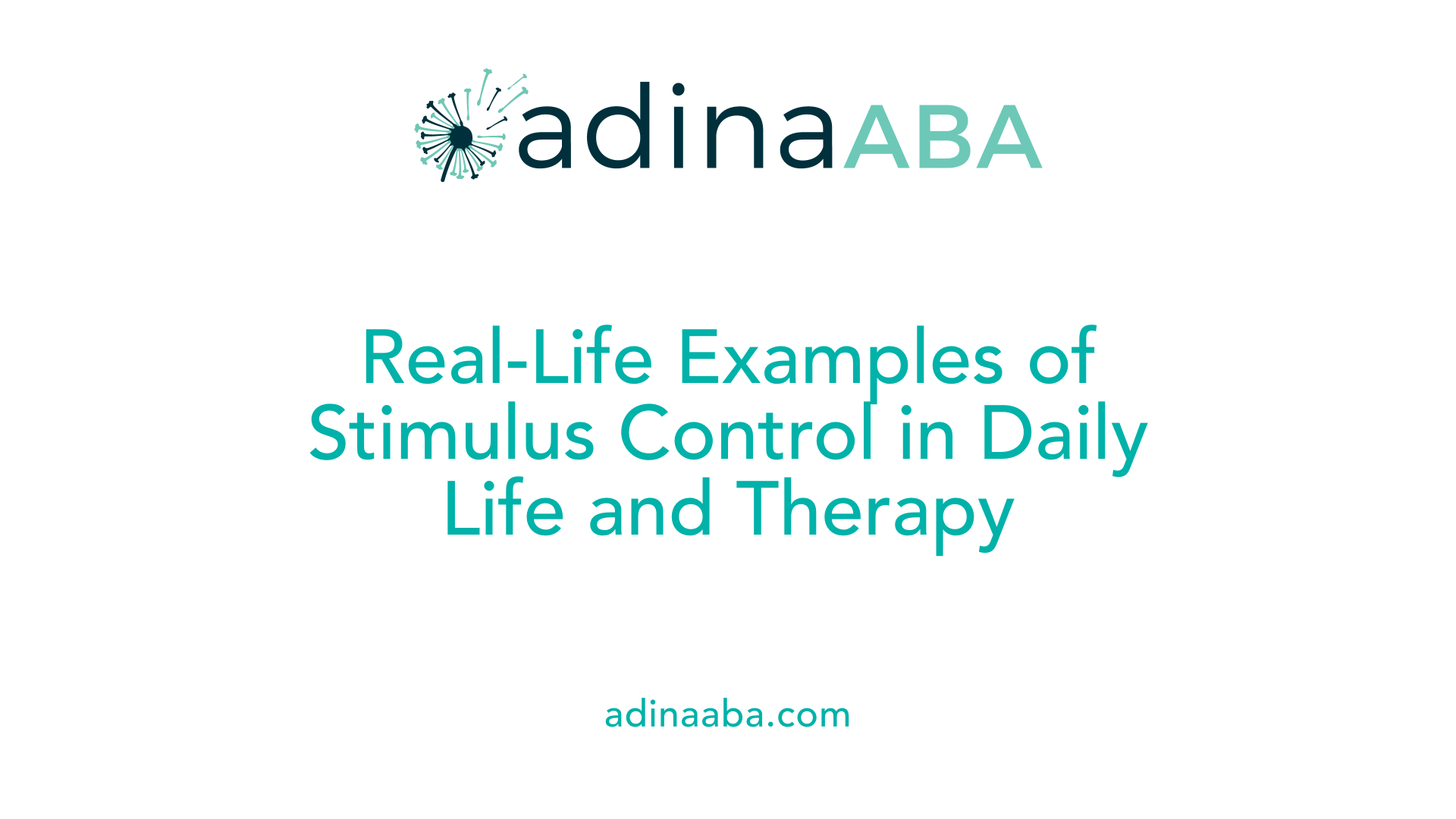 Stimulus control plays a fundamental role in how behaviors are guided and maintained both in everyday situations and clinical settings.
Stimulus control plays a fundamental role in how behaviors are guided and maintained both in everyday situations and clinical settings.
In daily life, common examples include stopping at traffic lights and stop signs, where the behavior (stopping) is controlled by visual cues in the environment. For instance, a driver responds to a red light by braking, demonstrating stimulus control by the traffic signal. Similarly, children might behave differently around certain adults—acting more politely or shy—because of particular social cues, such as tone of voice or facial expression.
In the context of Applied Behavior Analysis (ABA), stimulus control refers to behaviors that are triggered consistently in the presence of specific stimuli. For example, a child may reliably say "dog" only when seeing a Chihuahua but not in response to a Maine Coon cat. This shows discrimination training, where the child learns to respond only to relevant cues. Another example is a person seeking out hand sanitizer when they see the bottle because the visual cue controls the behavior.
In clinical and teaching settings, stimulus control extends to behaviors reinforced in particular situations. For instance, a client might say "Hi!" only when prompted by a therapist, indicating the behavior is under stimulus control by the prompt or cue. Praise from a teacher may also be more likely when the teacher is present, illustrating stimulus control by environmental factors.
Stimulus control becomes essential for teaching new skills and reducing maladaptive behaviors. It involves establishing conditions where responses only occur in the presence of relevant stimuli, and transferring this control is often achieved through systematic fading and reinforcement processes. These techniques help behaviors become more automatic and natural in everyday contexts, promoting independence and generalization.
Understanding stimulus control's influence on behavior helps practitioners design effective interventions, ensuring responses occur appropriately and consistently across different environments. Whether in training children to respond to natural cues or in managing daily routines, stimulus control helps align behaviors with real-world demands, making learned skills functional and sustainable.
Conditions for Effective Stimulus Control
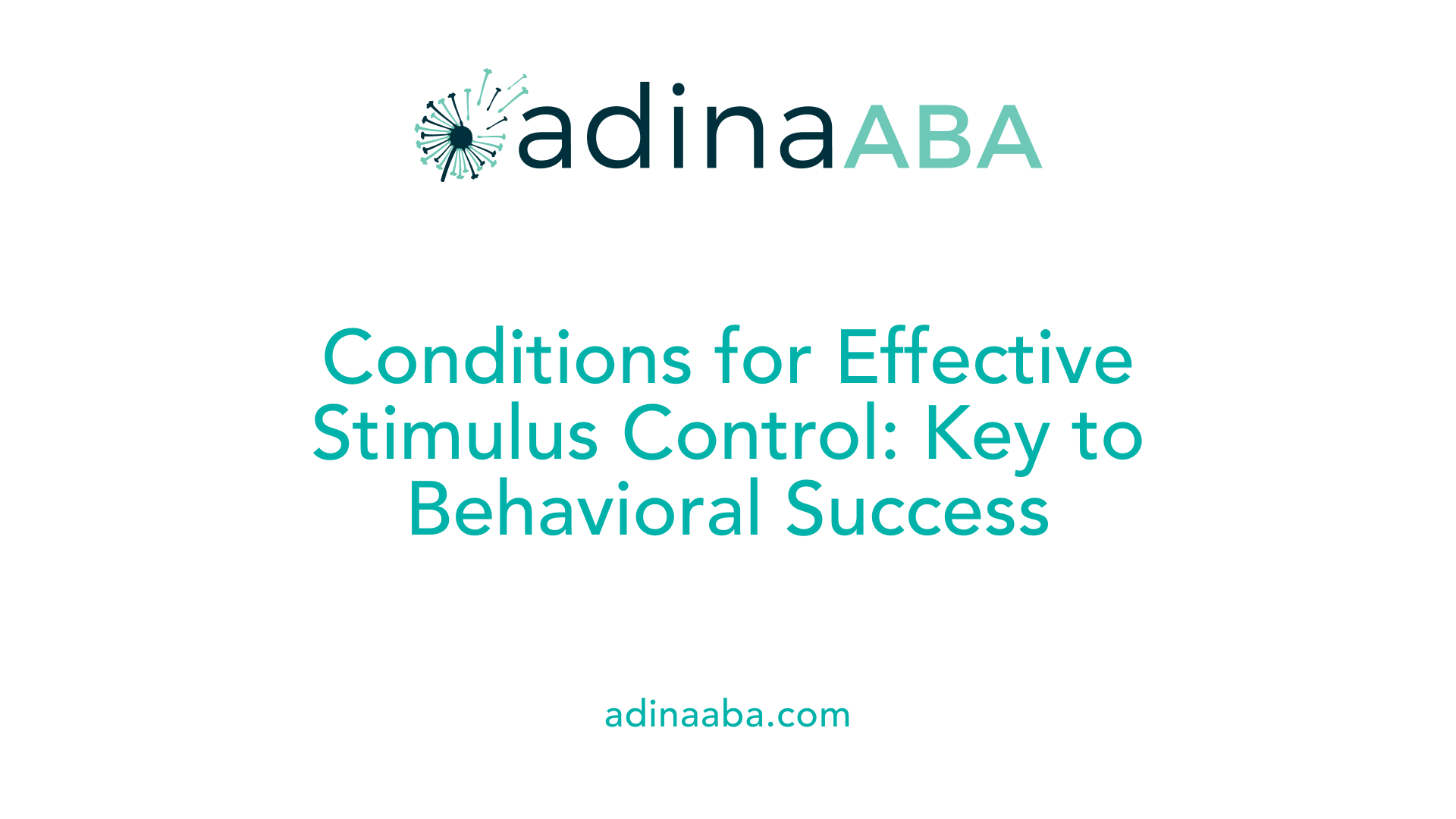
What are the conditions that define stimulus control over a behavior?
Stimulus control is established when a specific antecedent stimulus reliably triggers or suppresses a particular behavior. For effective stimulus control, certain conditions must be met to ensure that the behavior occurs in a predictable and consistent manner in the presence of the stimulus.
Primarily, the behavior should occur immediately upon the presentation of the stimulus. This means that when the stimulus appears, the response is emitted quickly and reliably. Conversely, the behavior should not happen when the stimulus is absent, indicating that the stimulus effectively discriminates when the response is appropriate.
Additionally, the response should be specific to the trained stimulus. The behavior must not be triggered by other stimuli that are irrelevant or similar but do not signal the same reinforcement contingency. This selectivity ensures that the individual responds only to the appropriate cues.
Stimulus control can manifest as either absolute or relative. Absolute stimulus control occurs when responses are exclusively tied to one specific stimulus, while relative control involves differences between stimuli that influence the individual’s behavior.
Overall, these conditions contribute to predictable and targeted responses, which are essential for effective behavior management and skill teaching in behavior analysis. Properly established stimulus control enables interventions to promote independence, generalization, and accurate responses across different settings and situations.
Importance of Stimulus Control in Behavior Modification
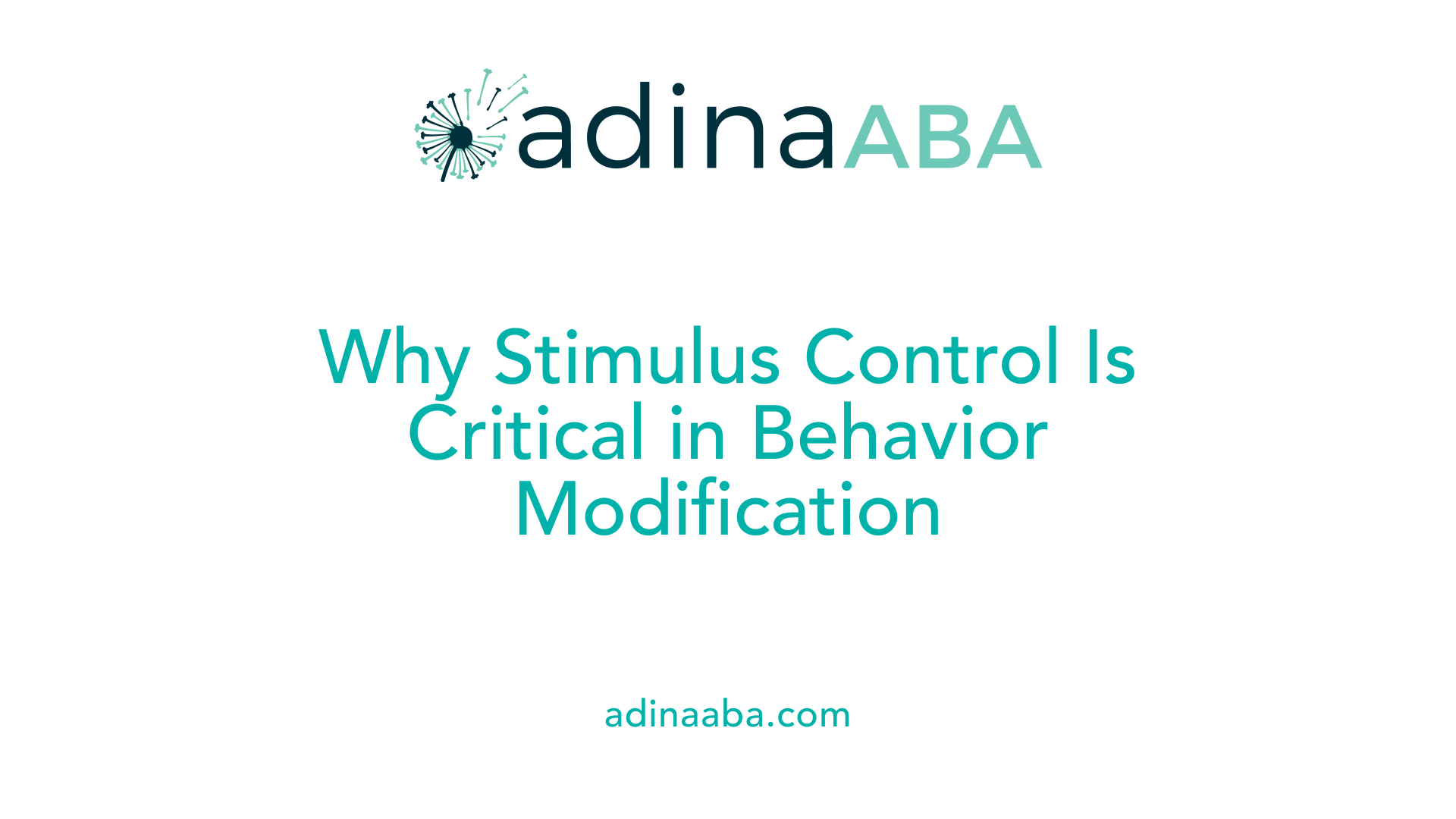
How does stimulus control help in shaping behaviors?
Stimulus control is fundamental in behavior modification because it creates a reliable link between environmental cues and specific behaviors. When a behavior is under stimulus control, it occurs more frequently or intensely in the presence of certain stimuli, making it easier to reinforce those behaviors only in suitable situations. For example, a child might say “please” when asked using a picture cue, but not without it. This process ensures that behaviors are contextually appropriate and sustainable.
By strengthening the connection between cues and responses, stimulus control facilitates the development of new skills, especially complex or social behaviors. Reinforcement is targeted to specific stimuli, making interventions more efficient. Teachers, therapists, and caregivers can use discrimination training—teaching responses to particular stimuli while ignoring others—to shape precise behaviors.
How does stimulus discrimination support behavior development?
Stimulus discrimination involves teaching individuals to respond differently depending on the stimulus presented. This ability is vital for adaptive functioning, enabling people to perform appropriate behaviors in different settings. For instance, a child learns to stop loudly talking in the library where silence is expected but may be allowed to talk loudly in a concert.
Discrimination training involves reinforcing responses in the presence of a discriminative stimulus (SD) and not reinforcing responses when another stimulus (SΔ) is present. This selective reinforcement helps individuals distinguish relevant cues from irrelevant ones, honing their behavioral responses.
What is the significance of stimulus control transfer for generalization?
Stimulus control transfer is essential for applying learned behaviors in natural environments. Often, behaviors learned in therapy or training settings are prompted or prompted behaviors, which may not automatically occur in everyday life.
Through methods like fading prompts or embedding responses into natural cues, stimulus control transfer gradually shifts control from artificial prompts to real-world stimuli. For example, a child might initially request a toy using picture cards, but through transfer procedures, they learn to use the actual object or a verbal request.
This process enhances independence, allowing behaviors to occur automatically in varied settings such as home, school, or community. It promotes the generalization of skills, reducing reliance on prompts and increasing functional applicability.
How does understanding stimulus control impact intervention success?
A thorough understanding of stimulus control informs the design of effective interventions. When behaviors are under strong stimulus control, they are more likely to occur when needed and be resistant to disruption.
Interventions often aim to establish stimulus control through discrimination training, prompt fading, and stimulus shaping. These strategies help eliminate faulty stimulus control—where irrelevant stimuli trigger behaviors—and foster appropriate responses.
Additionally, manipulating stimulus properties like salience (how much a stimulus stands out) and disparity (differences between stimuli) can accelerate learning. Higher salience or disparity typically leads to faster discrimination learning.
By transferring stimulus control from artificial prompts to natural cues, interventions become more sustainable and functional. This transition encourages behaviors to persist outside controlled settings, making long-term behavior change more achievable.
| Aspect | Description | Example |
|---|---|---|
| Facilitates skill development | Creates reliable stimulus-behavior links | Child responds to picture cue but not without it |
| Supports discrimination | Differentiates relevant from irrelevant stimuli | Responds to ‘stop’ sign but not to unrelated stimuli |
| Promotes generalization | Transfers response control to natural cues | Asking for water using verbal and contextual cues |
| Enhances intervention outcomes | Increases responsiveness and independence | Reduced prompts, increased spontaneous behavior |
Understanding and applying principles of stimulus control are integral to effective behavior therapy. They enable precise targeting, promote independence, and ensure that learned behaviors are adaptable across various environments.
Proper vs. Faulty Stimulus Control and Ensuring Reliability
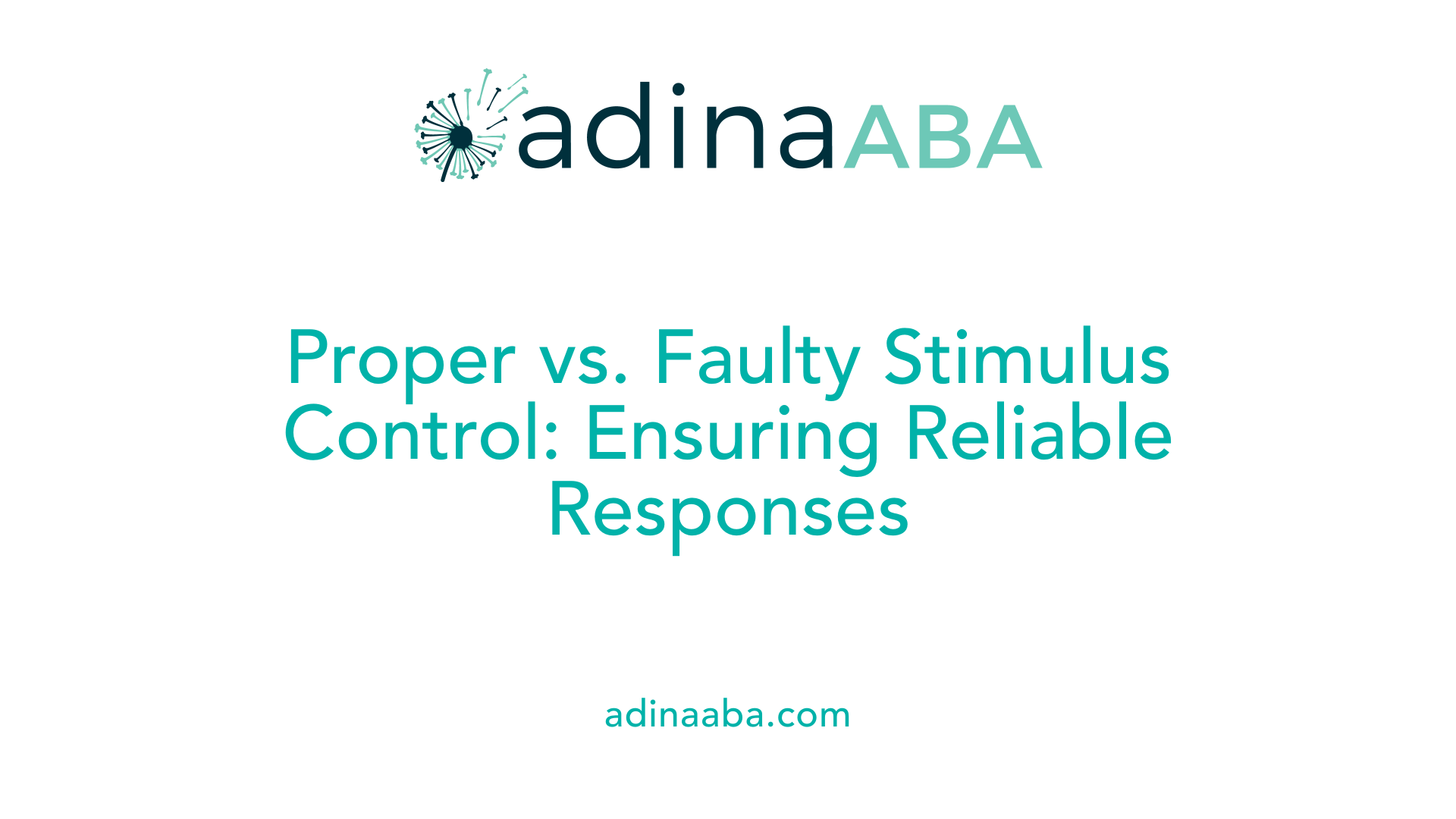
What is the difference between proper and faulty stimulus control?
Proper stimulus control happens when a behavior is consistently triggered by the correct environmental cue or stimulus. For example, a child asking for a toy when they see the toy in the room demonstrates proper stimulus control because the presence of the toy reliably evokes the requesting behavior.
Faulty stimulus control occurs when responses are triggered by irrelevant, unimportant, or confusing stimuli. This leads to inconsistent or inappropriate reactions, such as a child calling for a toy only when they hear a certain unrelated noise instead of the actual toy being present.
This problem can arise if stimuli presented during training are not clear or salient enough, causing learners to respond to unintended features. For instance, if a child is taught to discriminate between two similar colors but the shades are too close, the behavior may be triggered by irrelevant visual features, resulting in faulty control.
Conditional stimulus control, where responses depend on the presence or absence of other stimuli, can sometimes fail if the context isn’t properly established. For example, responding to a question only when a specific voice is heard requires clear cues; if these are ambiguous, responses may be inconsistent.
To achieve proper stimulus control, practitioners often use fading procedures—gradually reducing prompts or cues while increasing the disparity or salience of stimuli. Initially, stimuli with high contrast or intensity are used to establish correct responses. Over time, these are faded or modified so that the behavior occurs reliably in natural settings based on naturally occurring cues.
Fading procedures include techniques like stimulus fading, prompt fading, and stimulus shaping. These help transfer control from artificial prompts to natural stimuli, ensuring responses are consistent and appropriate. For example, a teacher may start with prominent visual cues to teach a child to identify colors, then gradually reduce these cues until the child responds correctly to natural color features.
Overall, understanding and differentiating proper from faulty stimulus control is essential for effective behavior intervention, ensuring that responses are both reliable and generalizable in everyday environments.
Final Thoughts: The Power of Stimulus Control in ABA
Stimulus control is a cornerstone of behavior analysis, underpinning effective teaching and behavior modification strategies. By understanding how specific cues influence behavior, practitioners can design interventions that promote discrimination, generalization, and independence. The process of stimulus control transfer ensures that learned behaviors become natural and functional, empowering learners to navigate and adapt in real-world settings. Mastery of stimulus control concepts like discriminative stimuli and stimulus delta is vital for optimizing intervention outcomes and fostering sustainable behavior change.
References
- What is Stimulus Control? - Applied Behavior Analysis
- Stimulus Control - Study Notes ABA
- Unlocking Behavioral Cues: A Deep Dive into Stimulus Control and ...
- Stimulus Control Research and Practice
- Understanding Stimulus Control Transfer In ABA Techniques
- Stimulus Control Transfer in ABA Therapy: When to Use & Why
- Stimulus Control Transfer in ABA Therapy
More Resources
Expert Clinicians
Get started today ->


.jpg)

.jpg)
.jpg)
